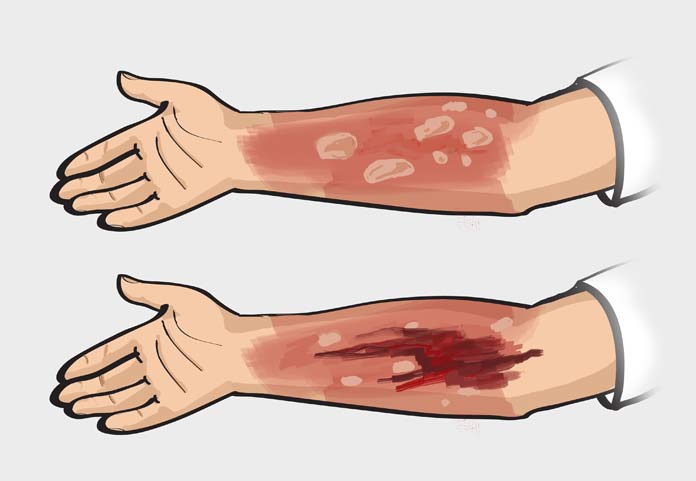Two men were injured when a generator battery exploded at Reading Intermediate High School on Wednesday, October 11. The men, both school maintenance employees, were attempting to start the generator during a power outage when the battery exploded splashing both of them with acid. One of the men suffered burns to his face and shoulders, according to a report in the Reading Eagle.
Generator explosion at #ReadingPA #Citadel hurts 2 workers; students sent home early. https://t.co/FdG6Rymk8S
— WFMZ-TV 69News (@69News) October 11, 2017
Firefighters and paramedics arrived at the school, located at 15 N 12th St., around 10:45 a.m. The men were transported by ambulance to Reading Hospital, where Lt. Trent Zulick of the Reading Fire Department told WFMZ 69 News, they both were in stable condition.
Skin Injuries from Chemicals in the Workplace
In the U.S., more than 13 million people work jobs where their skin can be exposed to chemicals, according to the Centers for Disease Control and Prevention (CDC). In addition to physical pain, the direct and systemic effects of skin-related injuries can cause “loss of work time and income, inability to perform job or loss of job, medical costs, quality-of-life issues, social handicaps, embarrassment, and self-consciousness, or low self-esteem,” according to the agency’s 2011 report called “Effects of Skin Contact with Chemicals: What a Worker Should Know.”

In the report, the CDC outlines the danger posed to employees whose skin is exposed to chemicals in the workplace and it encourages them to remember the acronym S-K-I-N. S stands for “social handicap,” meaning damages skin can affect the quality of life for a worker and his or her family. K stands for “knowledge” meaning information is the key to prevention and treatment of injuries. I is for “impediment” meaning “skin problems cause physical discomfort, limitations on your daily life, loss of personal and work time, and possibly the loss of your job.” And N stands for “not necessary” meaning suffering a work-related skin injury is not a requirement of any job.
The SKIN acronym is a good way to sum up the dangers chemicals in the workplace pose, said Fred Pritzker, an attorney who represents burn victims and their families in personal injury and wrongful death lawsuits.
“Despite advances in workplace safety, America remains a dangerous place to work. And, sadly, almost all workplace accidents are avoidable.”
Attorney Fred Pritzker
Chemical burns can “cause more tissue damage than any other type of burn” and their correct treatment depends on proper identification of the chemical, according to the authors of the 2011 study Occupational chemical burns: a 2-year experience in the emergency department. Of the 21 patients researchers from the Democritus University of Thrace in Greece studied, most sustained injuries to their upper extremities, followed by workers who suffered burns to their lower extremities and thoraxes. Two years after injury, four of them needed cosmetic surgery to remove excess scar tissue. Other long-term complications of these injuries include: infection, disfigurement, muscle damage, loss of a limb and emotional trauma.
Acid Burn Injuries to the Skin
Acid burns are a common type of chemical burn. The severity of an acid burn depends on how concentrated the acid is and how long it was in contact with the skin. Most chemicals will continue damaging the skin until they are neutralized or diluted with water, but further tissue damage can occur after the chemical is neutralized or diluted. In addition to causing a chemical burn that can leave permanent scarring, acid splashed on the skin can also damage respiratory and gastrointestinal tracts, according to the CDC.
Acid Burn Injuries to the Eye
Acid splashed in the eyes can cause temporary loss of sight or permanent blindness. In a 1997 study of injuries associated with motor vehicle batteries conducted by the National Highway Traffic Safety Administration, researchers found that 72 percent of the patients suffered injuries to their eyes, 22 percent suffered injuries to their face.
Preventing Chemical Injuries in the Workplace
Providing adequate training and proper safety equipment are key to creating a safe workplace for employees whose jobs expose them to chemicals, said Pritzker. To contact him for a free consultation about your legal options if you have sustained a chemical injury at work, use the contact form below to submit your contact information. Or, call him toll-free at 1 (888) 377-8900. There is no obligation.
